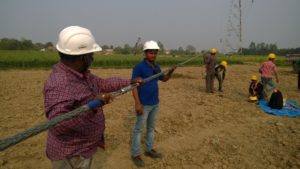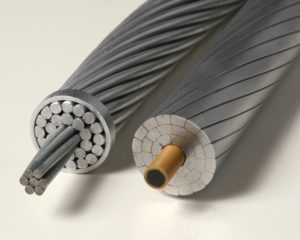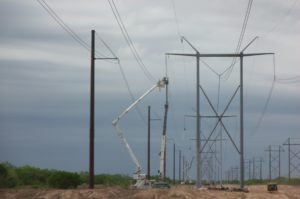US-based CTC Global Corporation has developed and owns the rights to the highly efficient ACCC (aluminium conductor composite core) technology. CTC Global has been in India for around six years now, working in partnership with conductor manufacturers Sterlite Power and Apar, apart from several hardware suppliers. In his very first interaction with T&D India, J.D. Sitton, CEO, CTC Global Corporation, states that he is very pleased with CTC’s progress in India, and that the subcontinent can potentially be CTC’s biggest market in South Asia. An interview by Venugopal Pillai.

India is a very conservative and price-sensitive market. Yet, CTC Global, as we understand, has successfully completed around 1,500 ckm of ACCC deployment projects in India, engaging around a dozen utilities. Are you satisfied with the progress?
My colleagues and I are very pleased with CTC’s progress in India. We have two very strong conductor manufacturing partners and several hardware companies working with us to serve the market in India. To date, roughly one half of India’s major state-owned transmission utilities are using ACCC conductor on critical circuits. A growing number of these utilities are repeat users and CTC and its partners are engaged with a number of additional utilities that are considering first-time projects using ACCC conductors.
The common theme among these utilities is the value they place on eliminating capacity constraints and improving the efficiency of their systems, and the confidence they have that ACCC conductor is, in fact, the best-value solution for accomplishing these objectives.
My colleagues and I are very pleased with CTC’s progress in India. We have two very strong conductor manufacturing partners and several hardware companies working with us to serve the market in India. To date, roughly one half of India’s major state-owned transmission utilities are using ACCC Conductor on critical circuits. A growing number of these utilities are repeat users and CTC and its partners are engaged with a number of additional utilities that are considering first-time projects using ACCC Conductors.
The common theme among these utilities is the value they place on eliminating capacity constraints and improving the efficiency of their systems, and the confidence they have that ACCC conductor is, in fact, the best-value solution for accomplishing these objectives.
“My expectation is that India will continue to be the largest market for ACCC conductor in South Asia going forward.”
CTC Global recently announced a new core manufacturing facility in Indonesia. This is the second such facility outside of the United States. Do you expect to create a facility in India any time soon?
 Yes, presuming demand for ACCC conductor in India continues on its current trajectory, it will make sense for CTC to develop a manufacturing facility in India.
Yes, presuming demand for ACCC conductor in India continues on its current trajectory, it will make sense for CTC to develop a manufacturing facility in India.
One of the things that I appreciate most about CTC is its ability to add value in markets where ACCC conductor is used. CTC’s objective is to invest in markets, relationships and people. Examples of this include China and Indonesia, where sustained market growth and partner support enabled CTC to develop in-country manufacturing facilities in 2015 and 2016 respectively. Today these facilities are operated by citizens of these two countries and each of them is ISO certified.
Tell us about CTC Global’s markets in south Asian countries. How does India fare with respect to its south Asian peers?
India was the first market for ACCC conductor in South Asia. CTC began serving this market approximately six years ago and now has over 70 projects completed or in-progress, at various voltage levels with 15 utility companies and two industrial users. My expectation is that India will continue to be the largest market for ACCC conductor in South Asia going forward.
That said, towards end of 2017 PGCB, the national transmission utility in Bangladesh commissioned its first project using ACCC Conductor and I expect that a number of additional projects will be commissioned there before the end of 2018.
Given that CTC Global now has a manufacturing facility in China, it is evidently a big market. Tell us how CTC Global’s growth in China has been, in recent years.
CTC established its JV in China in 2014 began manufacturing there in 2015 and received ISO certification in late 2015. CTC transferred the technology, managed the plant start-up and supported the certification process. Today the facility routinely operates at capacity and maintains a significant share of the market for high performance conductors in China.
Prior to establishing the manufacturing facility in China, CTC completed over 150 projects in several regions there. While government funding for infrastructure will fluctuate periodically, I believe that demand for electricity and an emphasis on clean infrastructure will result in a bright future for our JV and for the use of ACCC conductors in China.
“For CTC, 2017 was a banner year. The number of countries where ACCC conductor is being used increased to over 50.”
What have been key developments for CTC Global in 2017, worldwide?
For CTC, 2017 was a banner year. The number of countries where ACCC conductor is being used increased to over 50. CTC also added some very capable hardware and conductor manufacturing partners and launched production in Indonesia with a full factory. Shipments of ACCC core set a new record globally and CTC is seeing sustained demand growth in a number of key markets.
CTC made significant progress on important product and manufacturing process innovations and strengthened its supply chain by adding additional world-class suppliers. CTC expanded its network of licensed master installers and added a series of valuable installation support services to help ensure great outcomes for users of ACCC conductor.
Each of these accomplishments is important in its own right. And taken together, they demonstrate CTC’s desire to continue growing and improving and innovating in this very important industry.
We hear of a copyright-related case between CTC Global and another US-based company Mercury. Any comment?
 In 2016, the United States Federal Trade Commission issued an order barring Mercury Cable from manufacturing, importing or selling its copy-cat product in the U.S. market due to infringement of CTC’s U.S. patents.
In 2016, the United States Federal Trade Commission issued an order barring Mercury Cable from manufacturing, importing or selling its copy-cat product in the U.S. market due to infringement of CTC’s U.S. patents.
In 2017, the U.S. Superior Court found Mercury Cable and certain of its officers guilty of patent infringement. Mercury and its officers were ordered to cease all infringing activity under threat of significant civil penalties.
CTC has invested heavily to create its industry-leading products and capabilities and is working with its partners to make them available to utilities in India. CTC is seeking to protect its interests and those of its partners in India – we need to make sure that the underlying inventions and CTC’s ownership of them is respected in the marketplace.
It is often said that imitation is the sincerest form of flattery. This might be true in high fashion and entertainment, but in the utility business, responsible players respect the rights of others. This is important because it encourages ongoing innovation.
“CTC stands ready to work with discoms in India to accomplish their loss reduction and capacity increase objectives.”
India is pursuing a programme called UDAY that aims at improving the financial and operational performance of state-government utilities. There is an overall expectation that UDAY will help power discoms become financially more empowered to revamp and upgrade their network. How do you see this for CTC Global’s prospects in India?
UDAY (Ujjwal Discom Assurance Yojana) sets efficiency targets for discoms. These targets include reductions in power lost through transmission. CTC’s ACCC conductor is excellent at reducing these losses while increasing capacity within existing rights-of-way. So, as it is implemented, UDAY provides explicit financial incentives for discoms to reduce losses by deploying ACCC conductor on their systems.
CTC stands ready to work with discoms in India to accomplish their loss reduction and capacity increase objectives, whether motivated by UDAY or by a strong desire to accomplish these objectives in any case.
What specific approach can be recommended to Indian discoms to reduce their conductor related transmission losses thereby inching closer to UDAY’s objective?
 Discoms in India currently operate over 500,000 km of 33kV lines. Discom engineers and planners know which of these lines are the most heavily loaded and suffer the most throughput losses. CTC and its partners can work with these groups to select optimal ACCC conductors for these lines and to define campaign-style installation programs on a prioritized basis to address them.
Discoms in India currently operate over 500,000 km of 33kV lines. Discom engineers and planners know which of these lines are the most heavily loaded and suffer the most throughput losses. CTC and its partners can work with these groups to select optimal ACCC conductors for these lines and to define campaign-style installation programs on a prioritized basis to address them.
Doing this will dramatically reduce throughput losses and operating costs and will free up valuable generation capacity which can then be used for productive purposes.
Please share your vision for CTC Global over the next five years, say 2022. How do you see your company’s market in India shaping up by that time?
My vision for CTC is that it will have a dramatically positive impact on people around the world by enabling better access to electricity which is delivered in a very efficient manner. CTC aims to do this by working with world-class manufacturing partners to supply ACCC conductor (and other innovative products developed by CTC!) on an increasingly cost-effective basis to leading utility companies that need more capacity and that demand efficient solutions.
India is a key market for CTC. My team and I are convinced that ACCC conductor can add significant value to utility companies that are working to achieve the electricity access and environmental objectives established by Prime Minister Modi’s government. We deeply respect the progress being made towards accomplishing these objectives and we are looking forward to growing with our partners and with India for many years to come.


